SPACE DEBRIS REENTRY HAZARDS
INTRODUCTION

Image: ESA |
There are tens of thousands of pieces of space debris over 10 cm in size that are in low Earth orbit.
These are causing and will continue to pose significant hazards to space operations.
The vast majority however, pose no hazard to the Earth's surface, as they will totally ablate (burn up) during atmospheric reentry, when this occurs. |
SATELLITE LIFETIMES
A satellite in low Earth orbit (below an altitude of 1500 km) will lose energy due to air resistance, and drop slowly back toward the Earth. The upper atmosphere is very tenuous and its density decreases dramatically with altitude. It thus can take a long time to decay back into the Earth's lower atmosphere. The table below indicates the approximate lifetime of a satellite versus its initial altitude.
| Satellite Altitude |
Lifetime |
| 200 km | 1 day |
| 300 km | 1 month |
| 400 km | 1 year |
| 500 km | 10 years |
| 700 km | 100 years |
| 900 km | 1000 years |
ONLY LARGE BODIES POSE A REENTRY HAZARD

|
In general a space object has to be over 1000 kg (1 ton) in mass to be likely to partially survive the reentry process.
This includes derelict satellites, space stations and rocket bodies.
Only small pieces of these will hit the ground. |
REENTRY STATISTICS
The following histogram, compiled and drawn by The Aerospace Corporation Center for Orbital Reentry Debris Studies (CORDS) in California, shows that on the average one or two pieces of debris (greater than about 100mm in size) reenter the Earth's atmosphere each day.

SURVIVAL STATISTICS
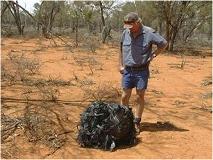 |
It has been estimated that of the 200 to 600 orbital reentries each year, about 20% may be large enough to have partially survived reentry and dropped at least some fragments on the Earth's surface.
This equates to an average of about 80 per year. Most of these will be small pieces, and most will drop into the ocean.
On the average Australia might be hit once in about 2 years by some type of artificial space debris. This is less than the meteorite hit rate. |
REALITY

Image: NASA/ODPO |
As far as we are aware no one, as of 2015, has been killed or even injured by any piece of reentering space debris.
One woman in the southern USA was hit by a piece of insulation from a US military satellite.
|
ESTIMATED RELATIVE RISKS
The Aerospace Corporation has compiled a table showing the estimated relative risks of common terrestrial events in comparison to deaths or injuries from meteorite falls and reentry events.
| EVENTS |
Daily Casualty Expectation |
| Natural Disasters 2009 | 29 deaths worldwide |
| Natural Disasters 2010 | 813 deaths worldwide |
| Work Accidents USA 2009 | 12 deaths |
| Motor Vehicle Accidents USA 2009 | 99 deaths |
| Unintentional Poisoning USA 2009 | 84 deaths |
| Homicide USA 2009 | 45 deaths |
| Falls USA 2009 | 68 deaths |
| Influenza USA 2009 | 8 deaths |
| Meteorite Falls Worldwide | 1.1 x 10-4 deaths or injuries |
| Reentry Event Worldwide | 2,7 x 10-5 deaths or injuries |
This means that once in 100 years someone, somewhere in the world may be injured or killed by a piece of reentering space debris. So we are dealing with a very low risk event at current population levels of space objects in low Earth orbit. And we should also note that the risk of being injured or killed by a piece of natural space debris (ie a meteorite) is greater than the risk of being injured or killed by a piece of man-made debris.
DEBRIS REENTRY SURVIVAL
The image below, from the NASA Orbital Debris Program Office, shows some large objects that have made it to ground.

Image: NASA ODPO
The next image shows a collection of small items that have survived reentry.

Image: NASA ODPO
Two basic types of debris have been found to survive the reentry process. These are refractory materials with very high melting temperature and interior or protected components that are not exposed to the heat of reentry until a fairly late stage in the reentry process. These are listed below:
AUSTRALIAN REENTRY DEBRIS LIST
The Aerospace Corporation in Los Angeles maintains a catalog of all known recovered reentry debris. At the end of 2013 the database contained 69 items. Of these, eight events occurred in Australasia (about one every five years).
These eight events are listed below:
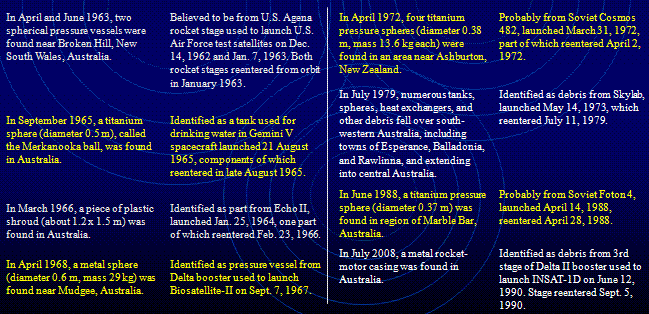
TWO WESTERN AUSTRALIAN REENTRIES
|
SKYLAB - 1979
In July 1979 the US space station Skylab reentered over SE Western Australia with a large number of objects impacting the ground. The Esperance museum contains the greatest collection of these items, but several museums in Australia have some Skylab debris items on display.
|
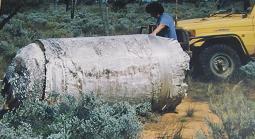
|
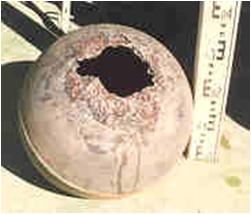
|
MARBLE BAR TITANIUM SPHERE - 1988
This was found by an employee of the Western Australia Water Corporation near the town of Marble Bar. We analysed it using an X-ray microprobe. Object was about 380 mm diameter, was almost pure titanium and showed melt flow around the attachment point. It had a CO2 laser weld around the equator and Cyrillic writing was visible on the surface. It was sold in 2005 in NY for $100K to a collector!
|
SKYLAB
In 1973 a Saturn 1B rocket lofted Skylab, the USA's first space station, into a low Earth orbit.
Because of the low orbit, atmospheric drag was working to make the orbit even lower. NASA was aware of this, but was hoping to reboost the station into a higher orbit with a rocket assist package carried into orbit by the Space Shuttle. Unfortunately delays in the Shuttle program combined with greater than predicted drag conspired to prevent this option from being carried out.
At 12:40 AM on the 12th of July 1979 the residents of the coastal town of Esperance in Western Australia were awoken by loud booming noises. Outside a spectactular display of multiple moving lights lit up the night sky for several minutes. Skylab had reentered the Earth's atmosphere, broken up and deposited multitudinous pieces of itself along about 1000 km of its final orbit. The day after the reentry and for some months (and even years) after the event, people recovered thousands of pieces that originally constituted the space station.
Many of these pieces ended up in the Esperance museum where they can be seen today. A must visit for anyone interested in looking at the diverse types of objects that can survive the reentry process.
THE REENTRY PROCESS
Uncontrolled reentries are always at very low grazing angles (<1 deg). The reentering object is travelling at about 8 km/sec down to below 80 km altitude.

Breakup starts at around 78 km altitude. This is termed the reentry interface. Time from breakup to impact is from 6 to 30 minutes. The length of the reentry footprint mostly depends on the reentry process above 50 km altitude. The width is also affected by tropospheric winds.
External items that have high drag (large area and low mass) such as solar panels will be shed first. After this catastrophic breakup begins, where the spacecraft begins to come apart and the individual items will then begin to experience their own drag. Drag is always greatest for items with low mass to area (m/A) ratios. These will lose their horizontal velocity more quickly than pieces with a high m/A ratio (ie massive compact items). The latter will retain their horizontal velocity for longer and thus will travel further. We expect these to end up at the furthest end of the ground footprint. This course of events may be changed if a low m/A item is 'shielded' within a high mass compact item.
Items can be spread out over almost 2000 km in the direction of travel. Orthogonal to this direction the footprint may be only 20 km, although with high and variable lower winds it might extend up to 70 km, particularly for low m/A objects. By the time a piece of debris makes it to the surface of the Earth (and most don't) it will have lost all of its space hypervelocity, and will be travelling at a terminal velocity determined by the lower atmosphere. This is around 50 metres per second.

THE REENTRY FOOTPRINT - COLUMBIA
The diagram below shows the actual debris field of the US Space Shuttle Columbia when it tragically made an uncontrolled reentry back to Earth.

Before reentry the mass of the Columbia was around 60 ton. A massive search recovered about 85,000 pieces which comprised 38% of the initial mass of the spacecraft. These were spread over a 1000 by 20 km footprint area. The total search cost was $US 300 million.
Despite coming down over a well populated area of the Earth there were no ground injuries. This in itself is testimony to the very low probability of being hit by a piece of space debris, even for the largest space objects in orbit.
REENTRY PREDICTIONS - AGENCIES
|
The US Strategic Command usually issues reentry predictions at the web site Spacetrack at 4, 3, 2, and 1 days and 12, 6 and 2 hours before expected reentry, and within a few hours after reentry.
The Aerospace Corporation CORDS (Center for Orbital Reentry Debris Studies), located in Los Angeles, issues predictions for large object reentries at least 5 days in advance at CORDS.
Some private groups or individuals publish reentry predictions. One group specialises in military satellite predictions (which are generally not provided by US government agencies).
None of the above prediction sources provide 100% coverage of reentries. |
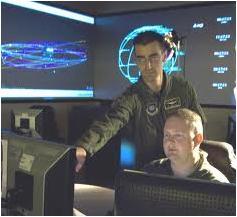 |
REENTRY PREDICTIONS - MODELS
The NASA Orbital Debris Program Office (ODPO) now routinely conducts a survivability analysis on all large satellites.
 |
NASA uses two models in this process. The simplified DAS (Debris Assessment Software) which is freely available, and the higher fidelity ORSAT (Object Reentry Survival Analysis Tool). Both of these are highly theoretical with very limited calibration data. Fortunately, most objects reenter over the ocean and tests of the predictions are few and far between. ORSAT graphical output is shown at left (NASA/ODPO).
|
Below is a detailed analysis using the NASA ORSAT model for the UARS (Upper Atmosphere Research Satellite) with an initial mass of 5668 kg which reentered in 2002.
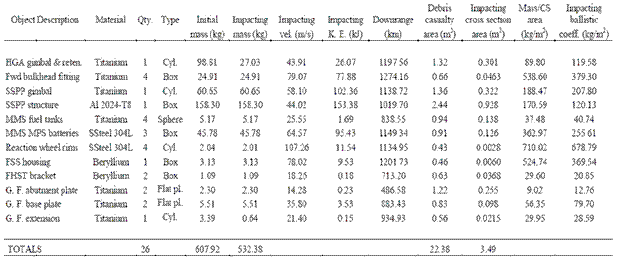
From the analysis we note that:
- only ~10% of the initial mass is expected to survive
- 26 individual objects are expected to survive reentry
- individual impact masses are generally less than 250 kg
- impact velocities generally range from 5 to 200 m/s with 50 m/s being the average (180 kph)
REENTRY PREDICTION ACCURACY
Timing predictions for reentries have a minimal error of 10 % (and sometimes up to 25%). This means that a week before the event we can only know the day of reentry. As a satellite nearing reentry makes over 16 orbits of the Earth during this time, a knowledge of where the reentry will occur is impossible.
A day before the event, we can confine the reentry path to a little over a single orbit. This can be used to eliminate large areas of the Earth, but anywhere under that single orbital path is a possible target.
Even two hours before the event the error is 12 minutes. For the satellite travelling at 8 km/sec this equates to a positional error in the reentry interface point of 5760 km ! And this does not include the 1000 km or so interface footprint over which the debris may be scattered.
Long term predictions
 Long term (one week to one year) can provide a statistical likelihood of the impact area (as shown) above based purely on the inclination of the satellite orbit (which does not change over these time periods).
Long term (one week to one year) can provide a statistical likelihood of the impact area (as shown) above based purely on the inclination of the satellite orbit (which does not change over these time periods).
A computer survival analysis for a particular satellite can also estimate the number of objects expected to survive and their total mass. (Image credit: Ailor/The Aerospace Corporation)
Medium term predictions
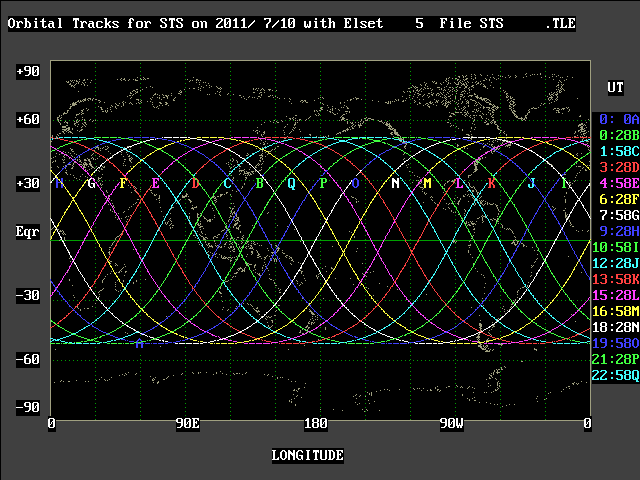 Predictions of a week or so can provide the day of reentry and a plot of the 16 or so orbits that the space object will travel over during that time. This can be used to exclude some areas from concern.
Predictions of a week or so can provide the day of reentry and a plot of the 16 or so orbits that the space object will travel over during that time. This can be used to exclude some areas from concern.
Short term predictions
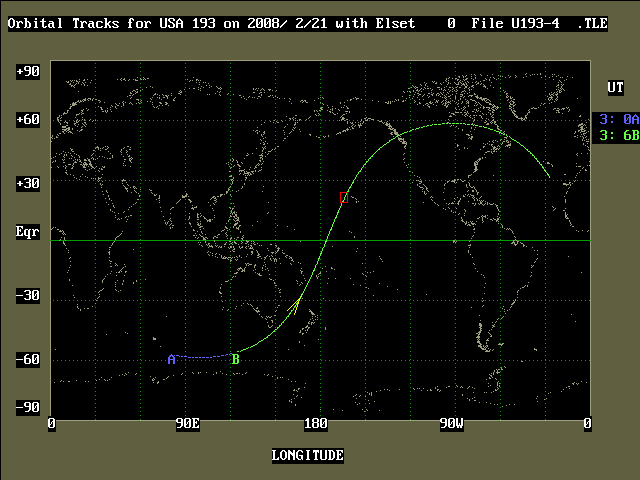 Predictions a day or less before the reentry event can generally indicate the orbit over which reentry will occur. This can be used to exclude large areas of the world, and a possible warning for the locations under the final orbit.
Predictions a day or less before the reentry event can generally indicate the orbit over which reentry will occur. This can be used to exclude large areas of the world, and a possible warning for the locations under the final orbit.
DEBRIS REENTRY HAZARD CRITERIA
- Injury or death will typically result if the impacting energy of a piece of debris exceeds 15 Joule. This is equivalent to a one kilogram mass (eg one litre milk carton) hitting someone at 6 m/s (20 kph), or a tennis ball hitting a person at 22 m/s (80 kph).
- A reentry hazard is declared if the estimated probability of one death exceeds 1 in 10,000. This essentially means that there would have to be 10,000 reentries of this exact type to cause one death anywhere in the world.
- An aircraft will experience catastrophic damage if it is hit by an object with a mass over 300 gm. The object velocity is generally not important as it will be substantially less than the velocity of a commercial airliner.
- An airspace hazard zone is declared if more than 27 objects are expected to impact in the zone. This is transmitted to pilots by the existing NOTAM (Notices to Airmen) system.
|


|
SPECIAL REENTRY EVENTS
The probability of injury or death from a space object reentry and the number of injuries or deaths that can occur are both so low that in most cases local emergency responses are the only necessary response to cope with a reentry event, and then only after it has occurred.
There is only one exception to this, and that is if the reentering object is known, suspected or found to contain radioactive (or very possibly) other hazardous materials, such that it presents no increased impact hazard, but a hazard if an unsuspecting person were to discover the reentered objects.
There are two types of radioactive components that have been carried by satellites or spacecraft in the past:
- RTGs (Radioisotope Thermoelectric Generators). These are used on deep-space craft that venture to parts of the solar system where solar power is inadequate to supply the operating power needed.
- Nuclear Reactors. These have been used mainly by the Soviets to supply the large power requirements of radar reconnaissance satellites in low Earth orbit.
RADIOISOTPE THERMOELECTRIC GENERATORS
 |
An RTG converts the heat from radioactive decay into electrical energy. RTGs are frequently used on deep-space missions to the outer planets where solar energy does not provide adequate power (too far from the Sun).
The radioactive isotope of choice is plutonium-238 (Pu-238). RTGs are normally only a reentry hazard if the launching rocket fails to reach its nominal orbit. Pu-238 is non-fissionable and US RTGs are very robust.
|
|
Maximum amount of Pu-238 is about 10 kg (for 200W of power). Pu is biologically toxic and is mainly an alpha particle emitter with some gamma. |
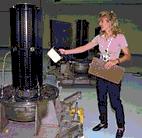
|
NUCLEAR REACTORS
Nuclear reactors have been used in space applications where high power is required. The US has placed one reactor in space and the Soviets ~33.
The Soviet reactors were used to power Radar Ocean Reconnaissance satellites used to track movements of US Naval vessels. They had very low orbits and solar panels could not be used because the drag would have caused reentry in a few days.
All remaining Soviet space nuclear reactors have been boosted into high orbits where they will not reenter for around a thousand years. The last RORsat was launched in 1988. Russia has stated that it is planning a 1 MW space reactor for 2020.
 | |
This is a scale model of a Soviet space nuclear reactor (Topaz) in a Moscow museum. The actual reactor was 4.6 m in length, weighed 980 kg, and had an electrical output of 5 kW.
All past reactors have used highly enriched uranium-235 oxide (90%), with a maximum fuel mass of < 50 kg.
|
CASE STUDY - COSMOS 954
|
This was a Soviet military radar ocean reconnaissance satellite that carried a nuclear reactor. The reentry footprint occurred over Canada. The main part of the reactor was deposited on a frozen lake, but the containment vessel of the reactor was breached and other radioactive contamination occurred across a large area. The cleanup cost to the Canadian government was $6M of which the Soviets paid $3M. No one was injured. Reentry occurred 24 January 1978 over the Canadian North-West territories in a footprint covering 100,000 square kilometres.
|
 |
The highest radiation levels encountered (~ 200 R/hr) could cause severe radiation sickness and death from only a few hours exposure. The cleanup operation, which the Canadians designated Operation Morning Light, lasted about 3 months.
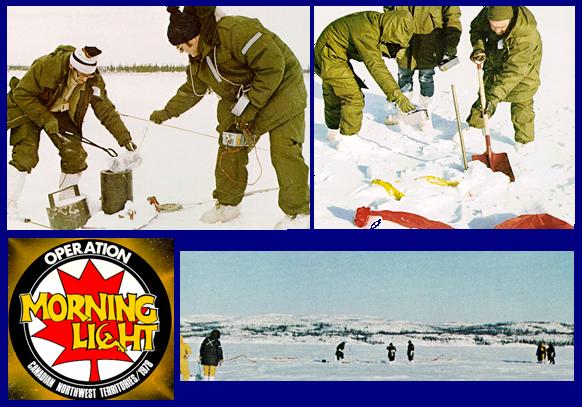
CASE STUDY - RUSSIAN MARS 96
 |
This was a Russian mission to Mars that failed to reach the correct Earth orbit. It carried an RTG. USAF Space Command determined that the reentry footprint could occur over Australia, but did not issue a warning to the Australian government, although a warning was issued to some individuals (mostly US government employees) in Australia via the US Embassy in Canberra.
|
The reentry actually placed debris not over Australia but over Bolivia and Chile. All evidence points to the fact that the RTG probably landed in the Andean mountains, but no-one has yet recovered it. And no directed search has ever been made!
This incident was of concern to the then Australian Prime Minister and resulted in the negotiation of a warning agreement between the US and Australia, as well as the generation of an Emergency Management Plan mainly involving ARPANSA (the Australian Radiation Protection and Nuclear Safety Agency).
SUGGESTED DEBRIS REENTRY HAZARD RESPONSE
Australia now has several emergency management plans to cope with
reentering space debris. However, because reentries are almost impossible to predict, and because damage probabilities are small and confined
to very small areas, the necessary response in most circumstances can
be coordinated after the fact and will only involve local resources.
Only in the instance of a known or suspected reentry of radioactive material
will a wider response be necessary. The following diagram indicates what we
believe is an appropriate response under the various indicated circumstances.

The issuance of any advice and alerts should always be tempered by the large
inaccuracies of any prediction (particularly with regard to possible area of impact), the very low probability of damage, injury or fatalities and should have regard to the anxiety and panic they may engender.
POST IMPACT OBJECT LOCATION
Most reentries will go unnoticed. Some may be stumbled upon years after the event. Only very bright reentries near populated areas generally have sufficient reports to give the necessary triangulation accuracy such that recovery may be attempted.
The Desert Fireball Network is a research project based at Curtin University under the direction of Dr Phil Bland. They are in the process of deploying over 50 sky sensors across Western and Central Australia. This network has the potential of locating reentered space objects to within a hundred metres. It also encourages public reports of fireballs to augment their sensors, and may be accessed at the web site Fireballs in the Sky.
SATELLITE, METEOR or REENTRY?
There are a few simple points you can use to determine whether an object you have seen in the sky is an orbiting satellite or large piece of orbiting space debris, a meteor or fireball, or a piece of reentering space debris.
ORBITING SATELLITE OR LARGE ORBITING DEBRIS OBJECT
 |
|
- a point of light, like a star, that moves slowly across the sky. The image shown here is a trail of light because of the time exposure. A satellite will be visible for a few minutes as it moves across the sky
- satellites and large pieces of debris orbiting the Earth shine by reflected light from the Sun. Because of this, and because any visible space objects are in low Earth orbit, they are only visible for one to two hours after sunset and one to two hours before sunrise. They may fade from view as they enter the shadow of the Earth
|
METEOR OR FIREBALL
 |
|
- a point of light that moves very rapidly across the sky. The motion may be so rapid that the eye sees it as a line or trail of light. It will be visible for only a few seconds at most - most meteors are visible for less than one second. A fireball is simply a very bright meteor
- meteors and fireballs shine by their own light, which is created due to the intense heat of entry into the Earth's atmosphere. Thus a meteor may be seen at anytime and anywhere across the sky
|
REENTERING SPACE DEBRIS
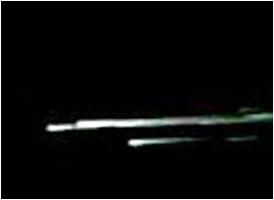 |
|
- a single point or several points of light moving moderately quickly across the sky. Because a debris reentry has a lower velocity than a meteor/fireball it will be visible for longer - normally longer than 10 seconds
- a reentering space object also is visible by the light (and heat) created in the reentry process
- reentry of a large object will be visible as multiples traces moving together. Reentry always occurs at grazing incidence. This does not mean it is parallel to the horizon, as grazing incidence passing overhead will appear to ascend into the sky - and then descend
|
AUSTRALIAN SPACE DEBRIS REENTRY RESPONSE PLANS
 Australian Space Academy
Australian Space Academy




































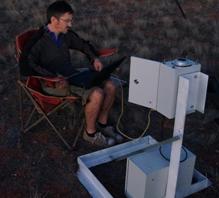



 Australian Space Academy
Australian Space Academy